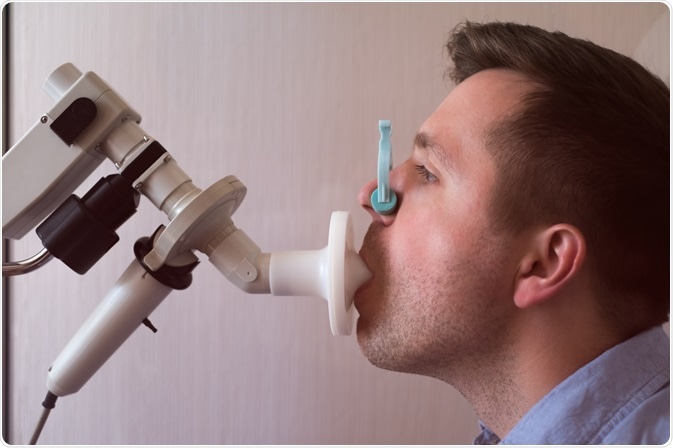Spirometry is a type of pulmonary function test that provides information about the function of the lungs and can be used for a variety of purposes. The test uses a spirometer, which is a specialized machine with a tube connected, to measure the speed and volume of air that is exhaled into the tube.

Image Credit: Koldunova Anna / Shutterstock.com
Indications
Spirometry is often used as a diagnostic tool for respiratory conditions such as asthma, chronic obstructive pulmonary disorder (COPD) and pulmonary fibrosis. Spirometry can also be used to monitor the function of the lungs, particularly for individuals that have symptoms of cough or shortness of breath.
Additionally, people who are at risk of damage to the lungs, such as those exposed to irritants in the occupational environment, may benefit from regularly spirometry tests to monitor any changes. Spirometry is also routinely included as a pre-surgical test to evaluate the risk of complications prior to many surgical procedures.
Some individuals should avoid spirometry tests due to an increased risk of adverse effects. Forced expiration places greater pressure on some regions of the body, including the eyes, chest, head and stomach region. For this reason, the test may aggravate recent symptoms or surgeries in these areas.
What is spirometry? A simple breathing test....
Procedure
Before a spirometry test, most people can continue daily activities as normal, although there are several factors that should be considered. Smokers, for example, should avoid smoking cigarettes for at least 24 hours before the test. It is also recommended that patients refrain from eating a heavy meal before the test, as it can affect the results. Additionally, some medications such as bronchodilators may need to be ceased before the test, depending on the specific case.
During the test, the patient is seated comfortably and a soft clip is placed over the nose to block the airflow. The patient will then be instructed to inhale fully to fill their lungs with air, place their lips around the mouthpiece and then exhale as forcefully as possible to empty the lungs completely. This procedure is usually repeated several times to allow the patients to understand how it works and a reliable result to be taken.
Depending on the purpose of the spirometry testing, it may be necessary to observe the changes resulting from taking an inhaled bronchodilator medication. This is particularly useful in the differentiation of certain types of respiratory disease, such as asthma and COPD. In this cases, tests should be repeated approximately 15 minutes following the administration of the medications to allow time for the effect to become evident.
The entire spirometry test typically takes between 30 and 90 minutes. Individuals can return to normal daily activities immediately after the test.
Results
There are several measurements relating to the volume and flow or air that can be determined with spirometry tests. The most important of these include forced expiratory volume in one second (FEV1), forced vital capacity (FVC) and peak expiratory flow (PEF).
The results of a spirometry will be compared to the predicted result, which is based on the age, body type, gender and ethnicity of the individual. Any result less than 80% of the expected value is considered to be abnormal and may be indicative of a respiratory disease.
An abnormal result may follow an obstructive pattern, which indicates an obstructive disease of the airways such as asthma or COPD. Alternatively, results may follow a restrictive pattern, thus indicating that the lungs are not able to fully expand, as which occurs in conditions like pulmonary fibrosis. Some cases also show a combination of both obstructive and restrictive characteristics.
References
Further Reading